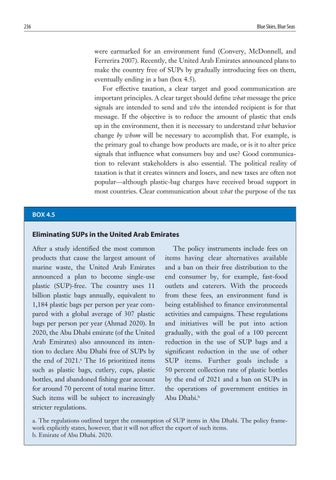236
Blue Skies, Blue Seas
were earmarked for an environment fund (Convery, McDonnell, and Ferrerira 2007). Recently, the United Arab Emirates announced plans to make the country free of SUPs by gradually introducing fees on them, eventually ending in a ban (box 4.5). For effective taxation, a clear target and good communication are important principles. A clear target should define what message the price signals are intended to send and who the intended recipient is for that message. If the objective is to reduce the amount of plastic that ends up in the environment, then it is necessary to understand what behavior change by whom will be necessary to accomplish that. For example, is the primary goal to change how products are made, or is it to alter price signals that influence what consumers buy and use? Good communication to relevant stakeholders is also essential. The political reality of taxation is that it creates winners and losers, and new taxes are often not popular—although plastic-bag charges have received broad support in most countries. Clear communication about what the purpose of the tax BOX 4.5
Eliminating SUPs in the United Arab Emirates After a study identified the most common products that cause the largest amount of marine waste, the United Arab Emirates announced a plan to become single-use plastic (SUP)-free. The country uses 11 billion plastic bags annually, equivalent to 1,184 plastic bags per person per year compared with a global average of 307 plastic bags per person per year (Ahmad 2020). In 2020, the Abu Dhabi emirate (of the United Arab Emirates) also announced its intention to declare Abu Dhabi free of SUPs by the end of 2021.a The 16 prioritized items such as plastic bags, cutlery, cups, plastic bottles, and abandoned fishing gear account for around 70 percent of total marine litter. Such items will be subject to increasingly stricter regulations.
The policy instruments include fees on items having clear alternatives available and a ban on their free distribution to the end consumer by, for example, fast-food outlets and caterers. With the proceeds from these fees, an environment fund is being established to finance environmental activities and campaigns. These regulations and initiatives will be put into action gradually, with the goal of a 100 percent reduction in the use of SUP bags and a significant reduction in the use of other SUP items. Further goals include a 50 percent collection rate of plastic bottles by the end of 2021 and a ban on SUPs in the operations of government entities in Abu Dhabi.b
a. The regulations outlined target the consumption of SUP items in Abu Dhabi. The policy framework explicitly states, however, that it will not affect the export of such items. b. Emirate of Abu Dhabi. 2020.






